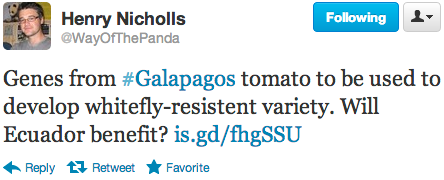A tweet alerted me to a story about the value of genes in crop wild relatives.

The source headline is “Galapagos tomato provides key to making cultivated tomatoes resistant to whitefly,” and though it reads like a press release 1 I have so far been unable to run down the original. I did, however, locate the event of note.
By now, Syarifin Firdaus should have successfully defended his graduate thesis on Whitefly Resistance In Tomato and Hot Pepper, which was due to take place today and which I imagine created all the interest.
My interest stemmed from the Twitterer’s question: “Will Ecuador benefit?”
The blurb for Firdaus’ talk makes it clear that after sampling almost 100 genebank accessions, wild Solanum galapagense had the strongest resistance and this seemed to be down to a single gene on chromosome 2. But it also pointed out that resistance was found in two other wild Solanum species, and in several Capsicums.
With these results, introduction of the resistance into modern tomato varieties is feasible and within a few years the first commercial, resistant tomato cultivars are expected on the market.
And that is a good thing not so much because whitefly damage the crop, but because they transmit virus diseases that are really harmful.
The release, which lists all the private sector companies involved in the research, strongly suggests that it will be genes from S. galapagense that will be bred into commercial varieties “within two years”. It also says that “resistance was also found in China, Indonesia and Thailand,” presumably in local tomato varieties rather than wild relatives.
Will Ecuador benefit? I seriously doubt it. Other wild relatives from Ecuador (and elsewhere) have already donated genes worth millions of dollars to the tomato industry, and no precedent has been set.
Should Ecuador benefit? Hard to see why. It isn’t as if S. galapagense (which until relatively recently was treated as a form of S. cheesmaniae, a well-established source of good tomato genes) has been maintained by farmers since time immemorial.
Best yet, tomato isn’t even listed on Annex 1 of the International Treaty on Plant Genetic Resources for Food and Agriculture. Solanum section tuberosa, sure; Solanum melongena, you bet. But Solanum lycopersicum and its wild relatives, outta luck.
Of course, the genetic resource in question might just be covered by the Convention on Biological Diversity, which offers Ecuador and its supporters a glimmer of hope, but I wouldn’t hold my breath.
What I really want to know is why S. galapagense is resistant? What are the insect pests on the Galapagos that exerted such strong selection pressure? Perhaps @WayOfThePanda can find out.
Some years ago we found resistance to potato spindle tuber viroid (PSTV) in Solanum acaule, a wild potato species (probably an alloploid) found at altitudes from 3000 to over 4000 m in the Andes (PhD study by Carlos Arbizu that I co-supervised). PSTV is a disease of much warmer environments so what the selection pressure for resistant S. acaule is hard to fathom – unless it was carried in one of the ‘ancestral alloploid genomes’, but conferred neither advantage or disadvantage in S. acaule itself.
We also found resistance to bacterial wilt (Ralstonia solanacearum) in some bred lines, but there was no indication in the pedigree from where resistance might have originated.
Regarding S. galapagense, I wonder if the accessions used in the study came from those that Charlie Rick made in the Galapagos (pre-CBD) and must be held in the Davis tomato collection, or somewhere in the USDA collection. I heard Rick talk about the uniqueness of this S. cheesmanii germplasm at a Solanaceae conference in St Louis in 1982. If pre-CBD there’s a lot of germplasm being used world-wide for which no financial benefits accrue to the ‘country of origin’.
Mike: There are 13 samples of Solanum galapagense deposited in Svalbard and therefore, under the terms of Art. 7 of the Svalbard `Depositor Agreement’, in the FAO Seed Treaty. I think this could be an AVRDC deposit, which is treated similarly to all CGIAR samples, which are in the FAO Treaty no matter if collected pre-CBD or of whatever species, Annex 1 or not.
The Svalbard accessions are from the US.
The Rick materials.
Yep.
Thanks for the clarification, David. So much of the ‘discussion’ around benefits focuses on financial gain, rather than access to improve germplasm that has cost someone somewhere considerable expense to develop. Those costs are often forgotten, or at least ignored in the debate.
Luigi: Thanks – I wish I could search databases like you can.
Related to our recent discussions elsewhere as to where samples/species originate, the Svalbard database has one sample of S. galapagense as country of origin the USA – with the others from Ecuador.
I agree with Mike – the important issue is access for research and development, rather than (my view) a dog-in-the-manger wait for uncertain future financial gain (and quibbles about where samples/traits/species originated).
Yes, I wondered about that USA country of origin. Must be a glitch in the system. This is the original record.